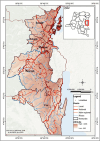The contribution of commonly consumed edible insects to nutrition security in the Eastern D.R. Congo
- PMID: 39003308
- PMCID: PMC11246483
- DOI: 10.1038/s41598-024-64078-5
The contribution of commonly consumed edible insects to nutrition security in the Eastern D.R. Congo
Abstract
Edible insects are perceived as an incredible opportunity to mitigate the major challenge of sustainably producing healthy foods for a growing world population in the face of climate change uncertainties over the coming decade. In this study, we assessed the nutrient composition and sensory properties of Acheta domesticus, Apis mellifera, Gnathocera trivittata, Gryllotalpa africana, Imbrasia epimethea, Imbrasia oyemensis, Locusta migratoria, Macrotermes subhylanus, Nomadacris septemfasciata, Rhyncophorus phoenicis, Ruspolia differens and Rhynchophorus ferrugineus consumed in Eastern D. R. Congo. The investigated edible insects are highly appreciated and nutritious, with proteins (20.67-43.93 g/100 g) and fats (14.53-36.02 g/100 g) being the major macro-nutrients, proving their potential to improve diets through food enrichment. The high potassium (24-386.67 mg/100 g), sodium (152-257.82 mg/100 g), magnesium (32-64 mg/100 g), iron (5.3-16.13 mg/100 g), calcium (25-156.67 mg/100 g) and zinc (11-19.67 mg/100 g) content make the assessed edible insects a useful mineral-containing ingredient for preventing undernutrition in countries which are plagued by micronutrient deficiencies. A scatter plot of matrices and Pearson's correlations between sensory attributes and nutritional composition showed a negative correlation (r = - 0.45) between protein and appearance. While no strong correlation was observed between nutritional attributes and sensory acceptance, a positive correlation was observed between potassium and aroma (r = 0.50), after-taste (r = 0.50) and acceptability (r = 0.52). Principal component analysis results indicated that the two axes accounted for up to 97.4% of the observed variability in the nutrient composition and sensory attributes of commonly consumed edible insects in the Eastern D. R. Congo. Given the significant delicacy and nutritional potential of edible insects highlighted in this paper, households can rely on the latter to meet their nutritional needs rather than conventional livestock, thus contributing to environmental and financial security through local business opportunities.
Keywords: Edible insects; Food insecurity; Nutritional potential; Sensory attributes.
© 2024. The Author(s).
Conflict of interest statement
The authors declare no competing interests.
Figures





References
-
- Desa UN. World population prospects 2019: Highlights. N. Y. U. N. Dep. Econ. Soc. Aff. 2019;11:125.
-
- Ishara J, Ogunyiola A, Matendo R, Kiyala JCK, Karume K. Climate Change and Its Implications on Food Security in the Great Lakes Region. In: Kiyala JCK, Chivasa N, editors. Climate change and socio-political violence in Sub-Saharan Africa in the anthropocene: perspectives from peace ecology and sustainable development. Springer; 2024. pp. 113–140.
-
- Van Huis A, Oonincx DGAB. The environmental sustainability of insects as food and feed. A review. Agron. Sustain. Dev. 2017 doi: 10.1007/s13593-017-0452-8. - DOI
MeSH terms
Grants and funding
LinkOut - more resources
Full Text Sources

